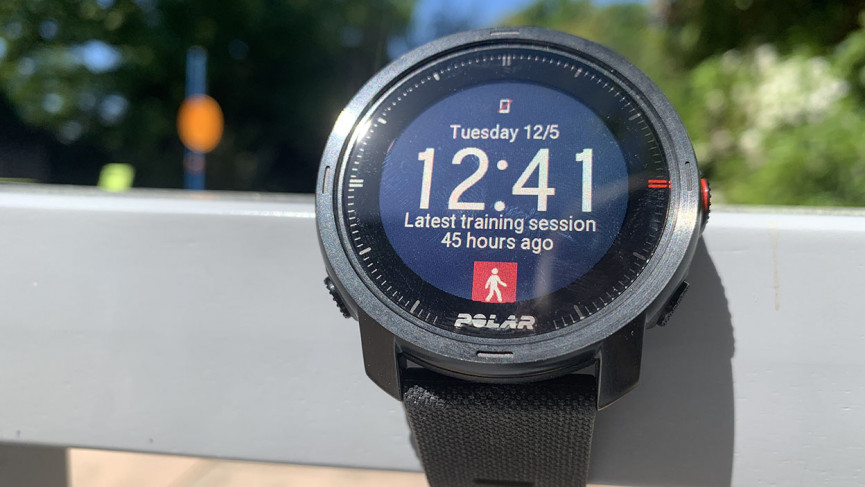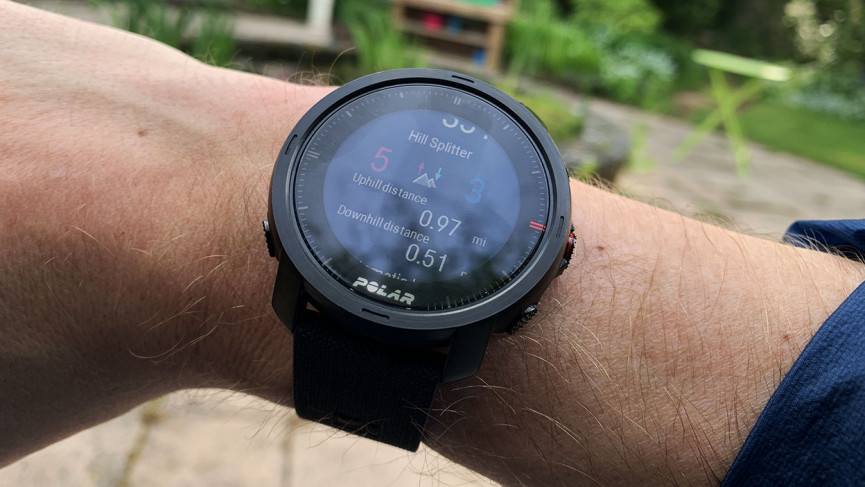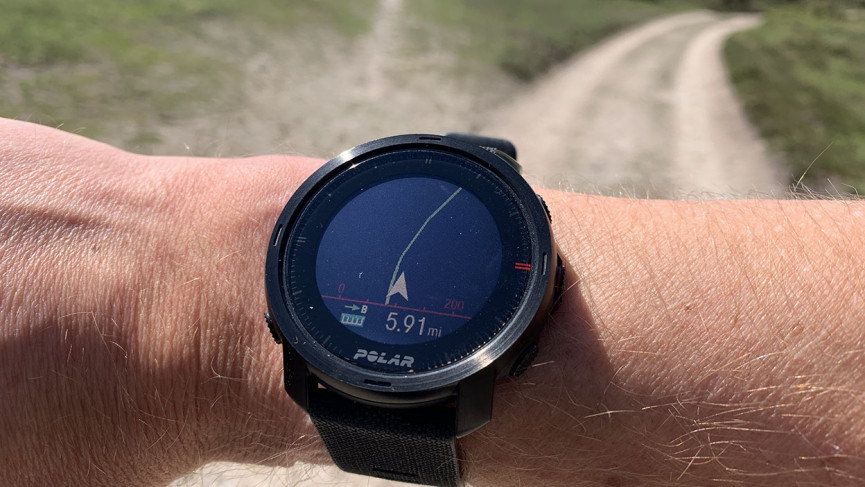
- Tailored fuelling recommendations
- Recovery insights
- Workout recommendations
- Big battery drain between workouts
- Laggy and surging heart rate
The Polar Grit X offers big battery life and a big focus on energy, nutrition and time out on the trails. It's the first watch built specifically for adventure and ultra-endurance – going up against the likes of Garmin and Suunto.
It's not designed for short distance road runners, that's for sure. The Grit X is more solid-looking than the refined Vantage V, has a longer battery life on paper than any Polar watch ever, and weaves in unique features that mean it's no Garmin clone.
You get smart fuelling recommendations, route guidance and hill tracking that potentially make it an ideal choice for mountain tamers, ultra runners and go-long adventurers. It's a serious outdoors watch with the specs to back it up.
As such it needed to be tested out on the trails – so as an ultramarathon veteran, I took it to the trails for a 40-mile ultramarathon.
It will draw inevitable comparisons with the Garmin Fenix 6 range, the Coros Vertix and the Suunto 9. But at it's nearly cheaper than the entry level Fenix 6S.
But does it really have enough to challenge the best in the outdoor adventure smartwatch on the market?
We put it to the test to find out in our Polar Grit X review.

Polar Grit X: Key Features
- 64g
- 47mm case
- 1.2-inch
- 240 x 240 pixel
- 22mm replaceable straps
- MIL-STD-810G durability
- 40 hours GPS battery life
- 100 hours tracking in low GPS mode
- 7 days smartwatch
- Optical HR
- GPS, Glonass, Galileo
- Running power and cadence on the wrist
- 130 sport modes
- FuelWise fuelling recommendations
- Hill Splitter segmented insights
- Turn-by-turn navigation
- FitSpark workout recommendations based on recovery
- Nightly Recharge sleep and recovery insights
Polar Grit X: Design and comfort

The Polar Grit X looks more outdoorsy than any Polar with some of the robust design language of a Garmin Fenix 6, but at just 64g, it actually feels more like a Forerunner 945 or a Vantage V on the wrist than it does a chunky Suunto 9, Coros Vertix or a Fenix.
Polar picks: Polar Vantage V2 v Vantage V v Grit X
It features a 47mm stainless steel case (in black or silver) and a fiber glass reinforced polymer back cover which presumably accounts for that 30 percent weight saving against the Fenix 6. That lightness was a welcome touch against the heavier Fenix 6 Pro during our 45-mile, 9-hour ultra test run but some may also feel it leaves the Grit feeling cheaper.

You get a 1.2-inch colour touchscreen and despite quite a large black frame there’s ample real estate to display the impressively wide range of stats which Polar crams on to this watch before, during and post-run.
The screen has a slightly improved contrast and clarity over the Vantage V, holds its own against the Fenix 6, and though it’s nowhere near the brightness and sharpness of an Apple Watch, it’s easy to read in most lights. But when you’re out on the trails, you’re trading a bit of crispness for plenty more battery life.

Overall, the Grit X is generally easy to use on and off the move, once you’re familiar with the logical interface. The touchscreen can be a bit laggy and feels somewhat unnecessary on an outdoors watch like this. We much preferred using the five side buttons controls which were nicely responsive, a marked improvement on the stiffness of the Polar Vantage V.
You get a decent array of sensors including the same Precision Prime optical heart rate sensor featured on the Vantage V; GPS, Glonass and Galileo location; a magnetometer-based compass for non-GPS guidance; and a barometric altimeter for more accurate elevation stats.
The Grit X sits comfortably on the wrist. Like any of the bigger sports watches, some people won’t want to wear it all day, but we found we quickly grew used to having it on 24/7, essential for making the most of the sleep tracking and recovery features.
In terms of durability, it’s water resistant to 100m and we only had one issue during our test, the clasp on the strap broke when we were taking it off. This might be an unfortunate one-off but this part of the watch didn’t feel the most robust. Luckily straps are interchangeable, though the mechanism is nowhere near as simple as you’ll find on the Garmin and Coros rivals.
On the plus side, Polar has mercifully stuck to the same charging cable as past models too, so if you’re upgrading you can charge with your old wires.
Polar Grit X: Sports tracking

In terms of sports tracked, the Grit X features 130 profiles – so it’s safe to say if you do it, the Grit X will track it. Or at least, tag distance, time and calorie burn correctly.
The mainstay is running, cycling, swimming and hiking – and of course nuances and variations in each.
For hikers, there’s a dedicated sport mode that lets you prioritise your training views to add an altitude graph, use that magnetometer compass and add fields like total ascent and current altitude.
Hikers can of course also make use of Hill Splitter, FuelWise and that Komoot routing but there’s nothing beyond that to specifically appeal to the fast packers and trail walkers.
But we’ve been focussing on endurance running, which pretty much tests the full gamut of features. However, these will also feed into activities such as hiking and mountain biking too.
Three headline features beef up the Grit X’s outdoors credentials: FuelWise fuelling recommendations, Komoot route guidance with planning and turn-by-turn and Hill Splitter.
Race fuelling and nutrition

FuelWise goes far beyond the simple time-based alerts that you can set on the likes of Coros and Garmin, using the intensity of your efforts – in combination with your height, weight, age and gender – to offer more precise reminders to eat during endurance efforts of 90 minutes or more. There is also a hydration alert but that’s a simple alarm where you choose the time between reminders.
In preparation for your event, you tell the Grit the duration, the estimated intensity based on heart rate zone and the size in grams of your carb portions. The Grit then spits out your total estimated carb needs and the number of feed portions, an excellent help when you’re preparing how much food to put in your pack.
During the run or ride, it then beeps on your watch to remind you to eat. We tested this over a 9-hour, 45-mile ultra run and it was excellent.
Reminders were spread at different intervals, it picked up when our intensity dropped and predicted hunger pangs more than once.
However, we found the reminder buzzes are a tad too similar to splits and because you’re not required to acknowledge you’ve eaten, they are too easy to miss. A simple button tap to say you’ve fed would solve that and a screen view of you feeds so far would be a great addition.
Post-workout you get a breakdown of the fuel sources used, split into carbs, fat and protein, including a really useful chart that shows what you were burning during your event.
A report on the times we ate and any feeds we skipped would also be great. But despite that, this is a brilliant tool that’s not matched on any other watch.
Hill tracking

In our tests on longer runs and doing hill reps, this feature was laggy.
The Grit X repeatedly took up to 0.2 miles / 200m to realise we were hacking up a hill. That limited its use for hill rep workouts.
In terms of mountain trails, the data you get feels limited compared to Garmin’s ClimbPro. You can’t add heart rate or power stats to the screen to see how hard you’re working in the segment, or see how far left for this particular climb. You also don’t see work rate insights broken into the splits in Polar Flow post session stats. Overall this feature felt lacking.
Navigation and mapping

Another outdoor feature that comes up a bit short is the Komoot-powered route planning and navigation.
Komoot itself is among the best tools for planning runs, hikes and rides off the beaten track and trumps Garmin’s route planning and Polar’s own tools.
However, the Komoot-Polar set-up was a faff and if you want to use Komoot’s third party mapping service outside of your local area, you have to pay an extra subscription fee. Not great for far-flung adventure types, or even those who might travel the country for ultra races.
Having said that, the turn-by-turn guidance on the watch was easy to follow and guided us successfully through some very tricky forest trails. You don’t get TOPO maps and that makes it feel a little sparse.
You get more detail including maps, estimated time to destination and a gradient chart of your entire course on Garmin’s implementation of Komoot. Though that doesn’t offer turn-by-turn.
Despite its billing as an adventure endurance watch, the Polar Grit X is a very capable regular sports tracking tool with a lot in common with the Vantage V and the Ignite.
You get the same 130 customisable sport modes for tracking everything from running to skiing. The same swim-tracking skills with stroke detection, lap tracking and SWOLF efficiency scores.
And the same Nightly Recharge feature for the very best in-depth sleep tracking and overnight Autonomic Nervous System recovery insights you can get, though the more pro-level Recovery Pro orthostatic tests aren’t supported.
Fitspark and home workouts

You also get: running power on the wrist, heart rate zone training and Strava Live Segments. The FitSpark recovery-based workout recommendations that launched on the Ignite are here too. These provide a selection of cardio, strength and mobility workouts based on your current state of readiness, a unique feature you won’t find on any other watches.
Training Load Pro helps you manage the effectiveness of your ongoing training, revealing if your recent efforts are detraining, productive, maintaining or potentially over-reaching.
The post-workout summaries on the watch provide excellent, easy-to-decipher, comprehensive detail and if you don’t want to dig deeper into your stats, you can get most of what you need on the watch. That includes Training Benefit readouts immediately post session show if you’ve improved your aerobic or anaerobic fitness during that workout. You’ll also still have access to Polar’s Running Index score, a handy way to chart your progress from run to run.
Finally, you’ll have the benefit of Polar’s very detailed Nightly Recharge feature which offers the very best in-depth sleep tracking and overnight Autonomic Nervous System recovery insights you can get, though the more pro-level Recovery Pro orthostatic tests aren’t supported.
Like most sleep tracking, the Polar Grit X is not without flaws. It has a habit of thinking you’re asleep when you’re watching Netflix on the sofa.
On the other hand, it was better than Garmin at clocking when we woke up rather than when we got out of bed.
Activity tracking and smartwatch features

Beyond your workouts, the Polar Grit X offers activity tracking with steps and active time as well as an inactivity alert.
Continuous heart rate tracking lets you keep tabs on your resting and max BPM. There’s also an effortless stationery fitness test to help you assess your estimated VO2 Max. It’s very much an estimate but it’s a useful benchmark for fitness progress.
You can pair it with your smartphone and get notifications, though these are read only, you can’t respond.
Polar Grit X: Sensors and accuracy
We put the Polar Grit X through a series or running tests up against the Garmin Fenix 6 Pro and a Stryd Wind Footpod. This included a 45-mile ultra, a 7-mile loop run, a half marathon with hill reps in full GPS mode, and a 45 minute interval session and an easy 5 miler in low power GPS mode.
It recorded virtually identical distances to the Garmin Fenix 6 Pro across all runs and both watches read marginally longer – within a tenth of a mile – of the Stryd footpod.
Heart rate accuracy comparison

Heart rate tracking is Polar’s home turf, it’s what the brand was founded on. The Grit X features a version of its flagship Precision Prime sensor tech with a 10-LED array and body contact sensors to help weed out any anomalous data.
Despite that, we found real-time heart rate was slow to respond to changes in intensity for pace and hill climbs. Much slower than the Garmin Fenix 6 Pro’s optical sensor and way behind Polar’s own H10 chest strap.
We also found that once it did catch up, it tended to lurch, leaping further and reaching higher or dropping more suddenly.
It fared much better on slower, steadier efforts and outside of workouts, the resting heart rate was more reliable against the chests strap.

Polar Grit X: Battery life
On paper the Polar Grit X claims seven days normal usage, with 40 hours GPS battery life in full tracking mode, extendable to 100 hours with lower GPS pulse rates.
You can customise the GPS power modes for specific sport profiles which is nice, and you can change modes mid-session. You also get a pre-exercise indication of the battery life in your selected power settings but you won’t get any of the smart battery suggestions you find on the Suunto 9.
We didn’t quite run for 40 hours to test that full battery life but based on a 9-hour ultra run with full GPS and heart rate on, and smart notifications off, the Grit X battery dropped to 69% against the Garmin Fenix 6 Pro’s 71%. So we’d suggest you’ll get closer to 30 hours full GPS on the Grit X.
With normal usage, we got closer to five days maximum battery with a 20% daily burn rate over a test period with no workouts. Throw in a regular week of workouts and that dropped to more like 4.5 days.
That’s slightly lower than the Garmin Fenix 6 Pro and we definitely found there was something on the Grit X guzzling juice between training sessions. The optical heart rate sensor seems to fire far more frequently than the Fenix 6 or the Vantage V, so that may be the drain.
How we test
